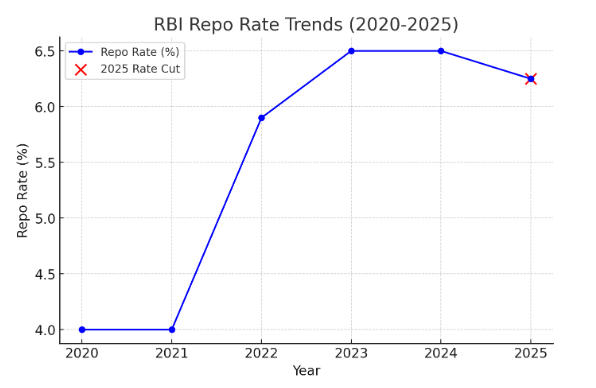RBI Monetary Policy 2025: Key Announcements, Impact, and Future Outlook
The Reserve Bank of India (RBI) Monetary Policy 2025 has been closely watched by economists, businesses, and investors. In its latest announcement, the RBI cut the repo rate by 25 basis points to 6.25%, marking the first rate reduction in five years. This decision aims to boost economic growth while keeping inflation in check.
In this article, we will analyze the key announcements, the impact on different sectors, and what lies ahead for the Indian economy.

Key Announcements in RBI Monetary Policy 2025
1. Repo Rate Cut to 6.25%
The RBI has reduced the repo rate from 6.50% to 6.25%, making borrowing cheaper for businesses and consumers.
2. GDP Growth Projection at 6.7%
The central bank estimates India’s GDP growth at 6.7% for FY 2025-26, expecting strong private consumption and capital expenditure.
3. Inflation Target at 4%
The consumer price index (CPI) inflation has moderated, allowing the RBI to focus on economic growth. The central bank aims to keep inflation near 4%.
4. Liquidity Support for Banks
To address the banking sector’s liquidity crunch, the RBI introduced measures to infuse liquidity into the system, ensuring smooth credit flow.
5. Sector-Specific Credit Boost
- MSMEs & Startups: Additional credit support to boost growth.
- Infrastructure: Focus on financing large-scale infrastructure projects.
- Housing & Real Estate: Policy support for affordable housing.
Impact of RBI Monetary Policy 2025
Impact on Consumers
- Lower EMIs: Reduced repo rates will bring down home loan, personal loan, and car loan EMIs.
- Increased Purchasing Power: Lower interest rates may lead to higher consumer spending, boosting demand in retail and services.
Impact on Businesses
- Cheaper Loans: Reduced borrowing costs will encourage business expansion and new investments.
- Stock Market Rally: A lower interest rate environment generally boosts equity markets.
Impact on Banking Sector
- Higher Loan Demand: Banks may see a rise in credit demand as lending rates drop.
- Liquidity Challenges: The RBI must ensure banks have enough liquidity to support credit growth.
Impact on Economy
- Boost to GDP Growth: Lower interest rates stimulate economic activity, supporting the 6.7% GDP growth projection.
- Controlled Inflation: RBI aims to balance inflation control with economic expansion.
Historical Trends in RBI’s Monetary Policy

Below chart and above table showcasing the RBI Repo Rate trends from 2020 to 2025, highlighting the expected rate cut in 2025.

Future Outlook for Indian Economy
- Possible Further Rate Cuts: If inflation remains low, the RBI may further reduce rates to stimulate growth.
- Global Economic Trends: External factors like U.S. Federal Reserve policies and global oil prices will influence future RBI decisions.
- Government Policies: The Union Budget 2025-26 will play a crucial role in shaping economic direction.
Conclusion
The RBI’s Monetary Policy 2025 reflects a strategic balance between growth and inflation control. The repo rate cut to 6.25% is expected to boost borrowing, consumption, and investment. However, liquidity challenges and global economic conditions will be key factors to watch.
For more insights on financial markets and economic policies, visit Marfo.in.

